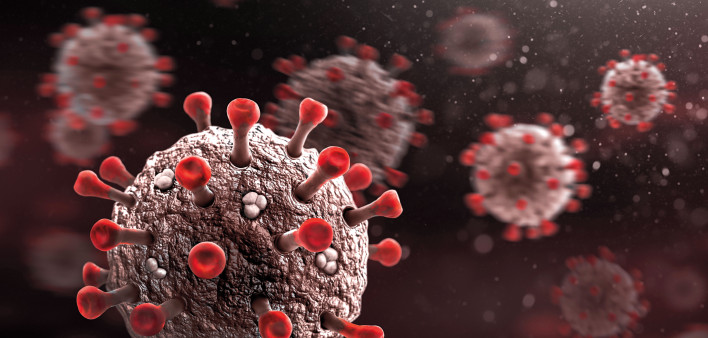HIV-positive people who recover from COVID-19 typically maintain viral suppression and do not have substantial long-term CD4 cell declines, but the new coronavirus may cause more subtle changes that can be identified using specialized tests, according to two recent studies.
To date, a majority of research indicates that people living with HIV do not have a higher likelihood of acquiring the SARS-CoV-2 coronavirus, nor do they appear to be at much greater risk of developing severe COVID-19 or dying from it. However, some HIV-positive people have had severe disease, and some studies have seen higher rates of COVID-19 complications in this population. Conversely, there has been little research on the effects of COVID-19 on HIV disease progression.
As reported in the Journal of Acquired Immune Deficiency Syndromes, Pierluigi Viale, MD, and colleagues at the University of Bologna in Italy evaluated changes in virological and immunological parameters among people with HIV who had COVID-19.
As background, they noted that the limited data on the immunological consequences of COVID-19 among HIV-negative people show that some experience prolonged low lymphocyte levels, which return toward normal only four to six weeks after COVID-19 diagnosis. Lymphocytes are immune system white blood cells, including CD4 and CD8 T cells. Two small retrospective studies saw significant decreases in CD4 cells, with larger declines in HIV-negative people with more severe COVID-19.
The present study included 14 people with HIV who had a positive PCR test for SARS-CoV-2. Two thirds were men, and the median age was about 53. A majority had one or more underlying health conditions, including hypertension, type 2 diabetes or obesity. At the time of COVID-19 diagnosis, all were on antiretroviral treatment, and all but one had an undetectable HIV viral load (below 50). The median CD4 count was 612, the median CD8 count was 917 and the median CD4/CD8 ratio was 0.69; two had a prior AIDS diagnosis.
Eleven participants (79%) had upper respiratory tract symptoms of COVID-19, and three (21%) had pneumonia; only the latter three were hospitalized. All recovered, and none developed acute respiratory distress syndrome or required intensive care.
Five people had low total lymphocyte levels (below 1,000), and three had low platelet counts (less than 150,000) at the time of COVID-19 diagnosis. After recovery, with a median eight weeks of follow-up, the median total lymphocyte count had risen to 1,609. At that time, the median CD4 count was 665 (ranging from 391 to 955), the median CD8 count was 886 (ranging from 513 to 1167) and the median CD4/CD8 ratio was 0.72. These changes in immunological parameters were not statistically significant, meaning they could have been due to chance.
All participants who started with an undetectable viral load maintained viral suppression, with none experiencing virological failure during the study period.
The researchers stressed that “larger cohort studies are needed to better understand characteristics and consequences of SARS-CoV-2 infection in HIV-positive people.”
In the second study, reported in Clinical Infectious Diseases, Timothy Henrich, MD, of the University of California at San Francisco, and colleagues looked more closely at the effect of COVID-19 on HIV levels, using a highly sensitive test that can measure down to a single copy of HIV RNA.
COVID-19 often leads to increased markers of immune activation, inflammation and immune dysregulation, they noted as background, suggesting that it is plausible that SARS-CoV-2 may have a short-term or longer-term impact on HIV disease.
The researchers therefore sought to determine whether COVID-19 increases the likelihood of having detectable but low-level HIV RNA that would not necessarily be detected by standard clinical viral load tests.
They used the single-copy assay to compare HIV RNA levels in large volumes of blood plasma from 12 HIV-positive people on antiretroviral treatment who had recovered from COVID-19 (a median of 37 days since symptom onset) and 17 whose plasma was collected before COVID-19.
In both groups, most were white men, and the median age was approximately 60. In the recovered COVID-19 group, the median CD4 count was 658, and 10 (83%) had detectable HIV RNA according to the sensitive test, with a median level of 1.59 copies per milliliter. In the pre–COVID-19 group, the median CD4 count was 537, and 59% had detectable HIV, with a median level of 0.38 copies. The differences between the two groups were not statistically significant.
Four people in the COVID-19 group with detectable HIV RNA were tested again a median of 75 days after symptom onset, and three were found to have persistent detectable HIV, with a median level of 1.95 copies.
Although the study was small and the differences were not statistically significant, the results “suggest that lasting perturbations of immune function and systemic inflammation may impact the natural course of HIV infection, potentially months following HIV infection,” the study authors wrote. “Whereas these low-level viremic episodes are unlikely to have direct clinical implications for patients, larger, prospective studies will be needed in order to fully understand the long-term impact of COVID-19 on HIV dynamics and viral immune responses.”
For more news about COVID-19, visit our sister site, COVIDHealth.com.







2 Comments
2 Comments